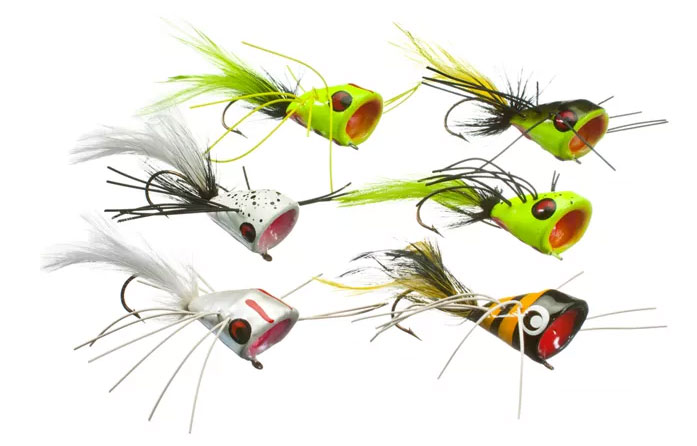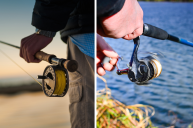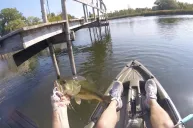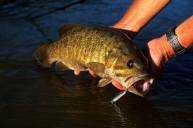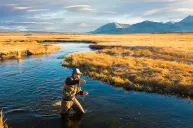Here are some tips for when you're ready to start fly fishing for bass.
Big bass have been a draw for fly fishermen for generations. Even though trout often take preference points, it's not uncommon for anglers who used their first fly rod to catch brookies or rainbows in small streams to make the transition.
Fly fishing and bass fishing should go hand in hand, but it can initially be a little intimidating. If you gear up with some streamers, topwater bass bugs, and weight-forward fly line then you would be headed in the right direction. But there's more to it than just equipment choice.
Fly patterns come and go, but most bass anglers will agree that once you've hooked a largemouth bass or a smallmouth bass on fly gear, you'll understand what the attraction is all about.
It might seem that bass fly fishing can be a bit daunting to get started, but it's really not. It may just be more about your mindset than your fishing skills. Once you've decided to fly fish for bass, we're pretty certain you won't regret it.
Bass Fly Fishing Gear
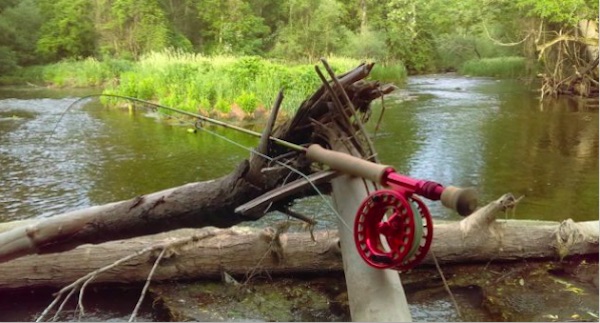
Craig Raleigh
It may be easy to stress over the type of rod to use for bass fly fishing, because it has to have enough strength to handle reasonably-sized largemouth or otherwise. A 5 to 8-weight rod with some weight-forward (WF) fly line that compliments the rod and will cast large flies works well for me (and for most bass).
Without much wind or heavy cover to deal with, a 5 to 6-weight will do, but for casting larger deer hair flies in wind, go up to an 8 weight.
A 7 to 9-foot rod works well (mine is actually 7'11") and usually have sufficient backbone to handle a bass. There are tapered leaders made specifically for bass action; look for something in the area of 3X leaders in the 10 to 15-pound range.
Many fly fishermen (myself included) simply make their own leaders from a good quality 10 to 15-pound test monofilament of their choosing, and anywhere from 5 to 8 feet in length depending on the conditions.

But what fly will you tie to all of this? There are as many good choices as there are bass in the lake it seems, but some are more proficient than others.
Some are as simple as the patterns that we use for trout fishing albeit in a bigger form such as terrestrials like grasshoppers and beetles. Woolly buggers work well, much like other larger bug imitations, but we are talking about bass here. Sometimes it seems like they'll eat just about anything.
Frog imitators and topwater poppers with rubber legs in multiple size patterns—especially colored in black or yellow—get raging strikes from bass, and floating line is typically best for such presentations. Don't forget the afore mentioned deer hair bugs. It can sometimes be a bit of a surprise to learn what the best fly for bass in your area turns out to be. Something inside your fly box, whether you've hit a fly shop specifically for bass or not, should work at certain points when the conditions line up.
For smallmouth bass the gear is much the same with a few differences, more so because you'll often be fishing streams and rivers. In this scenario, you will want imitations that mimic crayfish, minnows, and aquatic insects, but certainly frogs, leeches, mice, terrestrial insects, and even salamanders will get strikes.
When fly fishing for bass, it's more about the power than the finesse and panache that takes priority when fly fishing for trout.
Largemouth Bass Fly Fishing Tactics

These strategies aren't so much different from what you would already use for bass fishing, it's just that you now have a fly rod in your hands instead of your trusty baitcaster. For calm water, pick a target and stay with it, even if you have to cast several times to hit your desired spot. With the larger deer hair offerings or poppers, let the bait sit for a moment then strip it quickly to make ripples in the surface.
The next step is to use the twitch, twitch, retrieve motion to give it some variation and life, but don't let it sit still between strips. There are times when a rapid retrieve works like a charm. When a bass, like any predatory fish, thinks his prey is getting away he will strike.
There is almost no end to what you can do, so try some tactics you'd regularly use for bass and see what works.
It's also not out of the question that you can use a sinking line or a sink tip to ply deeper waters. In this case it's a simple matter of casting a streamer or other clouser minnow imitation and giving it time to sink based on your knowledge of the depth there. You can drag worm patterns across the bottom, bring baitfish-style flies into the strike zone, or drop bugs and terrestrials with weed guards amongst lily pads.
Depending on the weather conditions and feeding patterns, you will have to decide what is best: a slow retrieve or quick strips of the line.
Smallmouth Bass Fly Fishing
Fishing in slow-moving streams and rivers can be one of the best experiences that a fly fisherman can have, and bronze backs usually like to cooperate. When retrieving subsurface flies or streamers, watch for side movement or slacking of line, then set the hook, since smallies don't always hammer the bait.
With a fly fishing rig you have a fantastic tool for presenting the bait with a great deal of finesse. Veteran anglers know you'll often need something to keep wary smallmouth interested. Skilled fly fishing gear techniques can be downright irresistible for smallmouth when you find yourself in the right place at the right time.
On the other hand, there are times smallmouth bass can and will strike the moment a mouse or bugger hits the water, so be ready and stay in control of the line by keeping your slack to a minimum. Setting the hook should be done with the line and not so much the rod tip by keeping the rod low to the water and waiting for some resistance. This is always tough on fly fishers since conventional wisdom would say we are going to miss the fish. In fact, we are letting the fish hook itself, a classic bass fishing approach.
When the time is right, set the hook, and set it good. Don't try to pull off a gingerly trout set, that's far too gentle for bass!
Some of the best traditional flies include dragonfly nymphs and damselflies, caddis, and even mayflies. Smallmouths can't resist still water aquatic insect hatches and will readily feed on them when they are available. Maybe the best part is that smallmouth fly fishing can be done from a float-tube, kick-boat, canoe, or a stable fishing kayak.
Don't be afraid to try areas where you've caught fish before, but seem to be inactive. Chances are that fish have become finicky or just used to the normal routine of spinners, crankbaits, and soft plastics.
Whether you are fishing in shallow water or the deeper water you will mostly want to imitate the insects and baitfish that bass prefer. When it comes right down to it, sometimes a trout fly will work when a buzzbait won't.
And if you happen to catch some panfish along the way and fill some voids with bluegills or crappie, then all the better. The common bycatch of a typical day spent bass fishing can be extra fun with a fly rod. As it always is with fishing: as long as we catch something, we're happy.
Above all, once you recognize how accessible and realistic it truly is, fly fishing for bass in warm water lakes, ponds, and fisheries can become a favorite in no time.
There will always be a place for conventional bass fishing, as the momentum of that industry simply can't be stopped. But fly fishing for bass will continue to grow in popularity as more and more anglers from the South continue scratching their own itch for fly fishing.
Once anglers get to feel the hookset of a bass on a fly rod, there's rarely any turning back, which is why you'll continue to see more and more fly fishermen gracing your local bass-heavy lakes, ponds, and rivers.
If you haven't tried it yourself, go pick up a cheap setup and give it a chance!
Looking for a little more or even hot lunch for your hunting blind? Follow my webpage, or on Facebook and Twitter.

